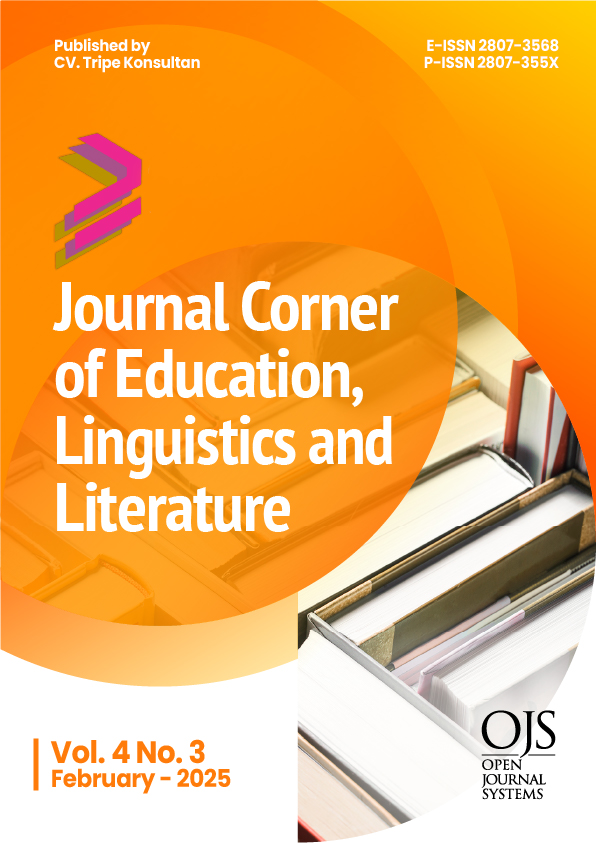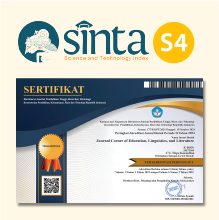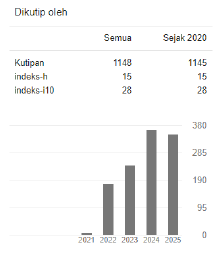Investigating the Use of WhatsAuto for Students' Consultation on Writing Narrative Project at X Grade SMK Muhammadiyah Tepus 2023
 https://doi.org/10.54012/jcell.v4i3.416
https://doi.org/10.54012/jcell.v4i3.416
 Abstract views: 190
Abstract views: 190
 PDF downloads: 164
PDF downloads: 164
Keywords:
Digital literacy, narrative writing, student's consultation, WhatsApp, WhatsautoAbstract
The study aimed to investigate the implementation process, benefits, and obstacles of using WhatsApp Automatic Reply (WhatsAuto) for students' consultation on writing narrative projects at X Grade SMK Muhammadiyah Tepus 2023. This descriptive qualitative research involved an English teacher and students from the X Grade as participants. Data collection methods included interviews, classroom observations, and documentation. The findings reveal that using WhatsAuto was conducted through structured activities divided into three stages: classroom activity, crosscheck, and submission. These stages allowed continuous interaction between students and teachers, supporting online and offline learning environments. The use of WhatsAuto provided several benefits, such as instant accessibility, flexibility, efficient communication, personalized learning experiences, and the promotion of digital literacy. However, some obstacles were identified, including varied levels of student understanding, low motivation, and technical issues such as poor network connectivity.
Downloads
References
Ajid, R., Reni, D., Utami, Y., & Sulisworo, D. (2020). The use of WhatsApp in English language classrooms: Optimizing mobile technology for learning processes. International Journal of Learning Technologies and Learning Environments, 2(4), 123–134. https://DOI:10.5861/ijrset.2018.3004
Anderson, M., & Anderson, K. (1997). Text types in English 2. Macmillan Education Australia.
Beetham, H., & Sharpe, R. (2013). Rethinking pedagogy for a digital age: Designing for 21st-century learning. Routledge.
Çam, B., & Can, Y. (2019). The role of WhatsApp in English language learning: An exploration. Journal of Educational Technology Research and Development, 67(5), 1073–1086. http://ijreeonline.com/article-1-896-en.html
Darmawan, A. (2020). Documentation in research: Understanding its relevance. Research Methods Review, 18(2), 45–53. https://DOI:10.3316/QRJ0902027
Dewi, A., & Atiyatul, H. (2020). Accessibility of online learning platforms during the pandemic: A focus on WhatsApp. Journal of Online Learning and Teaching, 16(3), 85–94. https://doi.org/10.32832/english.v14i2.3792
Hashemifardnia, A., Namaziandost, E., & Esfahani, F. S. (2018). The impact of WhatsApp on EFL learners' vocabulary retention. Journal of Applied Linguistics and Language Research, 5(3), 118–127. https://DOI:10.24093/awej/vol9no1.2
Kane, T. S. (2013). The Oxford essential guide to writing. Oxford University Press.
Keraf, G. (1989). Narrative composition: Development through time. Gramedia Pustaka Utama.
Kheryadi. (2017). The application of WhatsApp to improve students' English language learning. Journal of Educational Research, 11(2), 34–45. https://doi.org/10.58806/ijirme.2024.v3i5n07
La Hanisi, A., Risdiany, E., Utami, Y., & Sulisworo, D. (2018). WhatsApp as a medium for enhancing English learning in EFL contexts. International Journal of Technology-Enhanced Learning, 7(1), 55–68. https://DOI:10.5861/ijrset.2018.3004
Maghfira, D. (2021). Teachers’ practices in using WhatsApp for teaching English. Journal of Language and Literacy Education, 13(1), 45–57. https://jurnalstairakha.com/index.php/SKETCH/article/view/155/0
McDonald, C. R., & McDonald, R. L. (2002). The writing process: A practical guide. Prentice Hall.
Mulyono, H., & Suryoputro, G. (2020). Exploring the use of WhatsApp for online consultation in English language teaching. Journal of Education and Practice, 11(4), 27–34. https://DOI:10.1016/j.heliyon.2021.e07853
Muthaiyan, M., & Kanchana, K. (2016). A study on developing reading skills of engineering students through WhatsApp as motivational. International Journal of English Research, 2(3), 1-04.
Parera, J. D. (1993). Narrative text: A framework for students. Erlangga.
Patima, Sitti and Rosadi, Kemas Imron and Sukarno, Sukarno (2021) Use of Application Variations on Online Teaching in the Covid-19 Pandemic Era. International Journal of Social Science And Human Research, 4 (1). pp. 18-22. ISSN (print): 2644-0679, ISSN(online): 2644-0695
Patel, H., Pettit, M., & Wilson, J. R. (2012). Factors of collaborative working: A framework for a collaboration model. Applied Ergonomics, 43(1), 1-26. https://doi.org/10.1016/j.apergo.2011.04.009
Mog, Trevor. 2013. http://www.digitaltrends.com/mobile/whatsapp-hits-250-million-active-users/.
Yücel, Ü. A., & Usluel, Y. K. (2016). Knowledge building and the quantity, content and quality of the interaction and participation of students in an online collaborative learning environment. Computers & Education, 97, 31-48. https://doi.org/10.1016/j.compedu.2016.02.015
Downloads
Published
How to Cite
Issue
Section
License
Copyright (c) 2025 Rohmat Subangun, Ani Susanti, Ikmi Nur Oktavianti

This work is licensed under a Creative Commons Attribution-ShareAlike 4.0 International License.
All articles published in the Journal Corner of Education, Linguistics, and Literature are licensed under the Creative Commons Attribution-ShareAlike License (CC BY-SA).

















